Mayor Arakawa: Maui in State of Continued Perseverance

Maui Mayor Alan Arakawa, State of the County Address 2017. PC: Wendy Osher.
Maui Mayor Alan Arakawa delivers his 2017 State of the County Address tonight before a full house at the McCoy Studio Theater at the Maui Arts and Cultural Center saying, “the State of Maui County is one of continued perseverance, we remain strong, and we continue to move forward. Our journey continues as we execute our plans for the future and work towards the goals we set for the community.”
The address highlights the County’s achievements in 2016, as well as plans for the coming year.

Ikaika Blackburn performs the National and State anthem at the Mayor’s 2017 State of the County Address. PC: Wendy Osher.
Scroll down below to view a complete text of the Mayor’s State of the County Address.
Aloha and good evening,
Mahalo for those of you joining us here tonight at the Maui Arts and Cultural Center’s McCoy Theater.
ARTICLE CONTINUES BELOW ADFor those of you watching us live on Akakū Television, channel 55, mahalo for joining us. We would also like to welcome those watching on K5 on Hawaiʻi News Now, which is being broadcasted statewide, as well as those watching the live stream online by KHON and KITV. Welcome, and thank you for taking time our of your busy evening.
Welcome to Maui County’s 2017 State of the County address, in this, the seventh year of our administration.
Overview of Recent Successes:
We have been on quite the journey so far. We have paved miles of county roads, repaired water main breaks and cleaned up wastewater spills. We expanded Maui Bus routes and increased senior services. We have created new parks and have plans to expand and build more. The bond rating company Fitch has affirmed that Maui County once again has one of the highest bond ratings in the state, double-A plus. We remain committed to helping Maui County reach the 100% renewable energy goal set by the state and by our community.
We have responded to tsunamis, hurricanes, freak lightning storms and a very, very destructive flood. Not to mention the heavy rains and flash floods that seem to be happening almost weekly.
ARTICLE CONTINUES BELOW ADAnd so, because the State of Maui County is one of continued perseverance, we remain strong, and we continue to move forward. Our journey continues as we execute our plans for the future and work towards the goals we set for the community.
Because in the end, if you fail to plan, you plan to fail. And plans that you don’t follow through on, or execute, might as well be figments of your imagination.
Plans for 2017:
In 2017 our plans include:
– protecting our shorelines
– recycling wastewater
– promoting the collection, storage and use of more renewable energy
– creating more affordable housing and reducing homelessness
– expanding sustainable agriculture
– improving the economy and
– continuing to maintain and improve upon our county infrastructure.ARTICLE CONTINUES BELOW ADThe first topic, protecting our shorelines, is a long-term project that I have been working on since I was first elected to office as a council person back in 1994. What this means is curtailing any new developments on our beaches and shorelines will be curtailed.
Looking at a map of Maui, you’ll notice that many of our shorelines are already protected because they are owned by state government and private land trusts. This is not a construction moratorium, but the fact is that developers won’t be able to buy and develop land that isn’t up for sale.
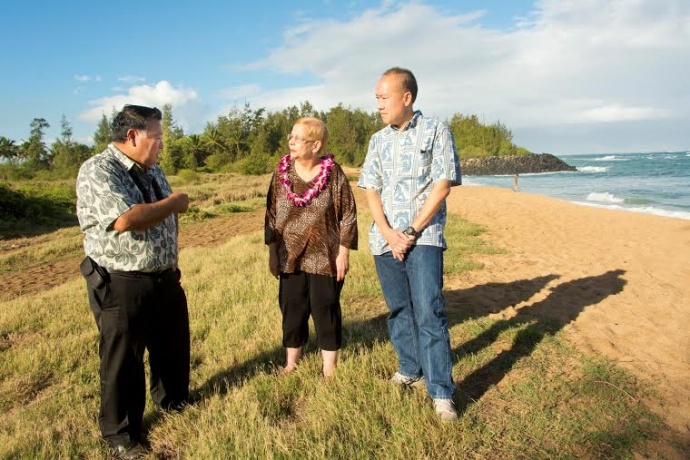
Site visit 11/1/14 at Paia beachfront acreage (Mayor Alan Arakawa, Council Chair Gladys Baisa and Grant Chun, Vice President, A&B Properties, Inc.). Photo credit: County of Maui / Ryan Piros.
County Seeks Coastline Property
ARTICLE CONTINUES BELOW ADARTICLE CONTINUES BELOW ADWhat the county has done is we have either bought, are proposing to buy or seeking control of the tracts of land on the coastline.
Starting in West Maui we own all 148 acres in Launiupoko, and after Olowalu the county and the state own all the parcels from Ukumehame to Papalua Beach Park. Unfortunately one of my great regrets is not buying the 880 acres which makes up Olowalu for $8 million when we had the opportunity. We could have protected that area from development as well.
That protection continues all the way from the “pali” to Wailea, which is part of the state beach reserve and part of the King’s Trail.
Continuing on the North Shore, the county helped Hawaiian Islands Land Trust to secure 247 acres from Waiheʻe River to Halewaiu Road. After that the shoreline is comprised of mostly state and county parcels all the way to the Wailuku River, and after that you have Kahului Harbor, Kanahā Beach Park and Baldwin Park.
In Pāʻia we acquired 25 acres of former sugar cane land between Baldwin Beach Park and Lower Pāʻia Park. The area will be master planned this year to become the North Shore Regional Park, which will connect both Baldwin and Lower Pāʻia parks as one big park system.
Further down Hāna Highway we are looking at acquiring as much coastline as possible. This includes expanding Hoʻokipa Park and acquiring Maliko Gulch.
Last year we submitted a proposal to council that the county take over the land through an agreement with Alexander & Baldwin. If approved by council, the area would stretch from “Jaws” (Peʻahi) through Maliko Gulch and head from the point to Hoʻokipa Park.
This is similar to Council Chair’s Mike White’s vision for Hoʻokipa. The acquisition of the land next to it would allow us to develop more parking, as the park becomes more and more crowded with visitors, locals and surf enthusiasts.
This journey to keep our shorelines safe from development through acquisition has taken almost twenty years, but the end is finally in sight. We look forward to hearing from our council members about their decision on some of these properties.
As a secondary benefit, this practice of buying up beachfront properties also serves to prevent more homes, hotels, condos and other structures from falling into the ocean because of shoreline erosion and rising sea-levels.
According to a recent study by the University of Hawaiʻi, during the last 100 years Maui has lost 11% of our beaches due to erosion. That’s four miles of our sandy beaches that have completely disappeared.
In fact the annual erosion rate in the state is greatest on Maui. This means any new hotels or resorts or other developments will have to look to more stable land further mauka of our coast. Either way you look at it, the development of our shorelines on Maui has been severely curtailed. Our Maui beaches are for Maui families, and will stay that way for our keiki, for generations to come.
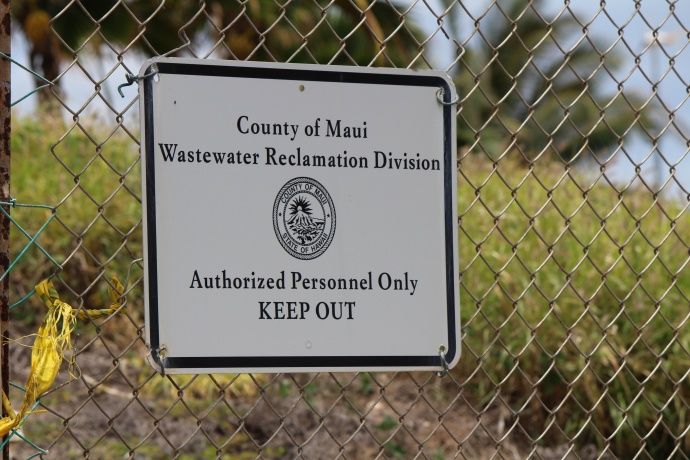
Wastewater Reclamation Facility sign, Maui. File photo by Wendy Osher.
Ending Injection Wells as Primary Disposal Method in Central & South Maui:
The coral reef system is part of our shorelines as well, and we are committed to caring for them as best we can. Therefore, we have come up with a plan to end the use of placing treated wastewater into injection wells as the primary disposal method in Central and South Maui, through two innovative projects from the Department of Environmental Management.
The first project involves creating a tree farm in South Maui, using wastewater from the Kīhei Wastewater Treatment Facility. Treated wastewater from the facility will irrigate about 150 acres of parkland mauka of Piʻilani Highway near our treatment plant. This area will be used to cultivate trees that can be used for county projects and beautification purposes, and serve as a walking nature park for the community.
The second project is in Central Maui, where we are working to acquire the old Maui Pine washwater line, which we would use to transfer treated wastewater so we can irrigate our county parks and at state facilities, throughout the Kahului area.
Both of these projects are in the planning and design stage and should be operational in two years. If successful, these projects would help the county re-use approximately 7 million gallons of treated wastewater a day.
This means that in the future, the only time the county would have to actually use injection wells to dispose of treated wastewater in Central and South Maui, would be during an extreme emergency.
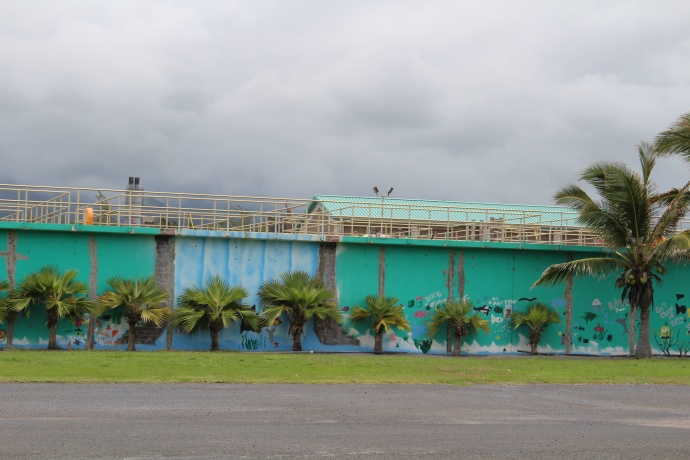
Wailuku-Kahului Wastewater Reclamation Facility in Kanahā, Maui. Photo May 2015 by Wendy Osher.
Making Use of Methane Gas:
DEM has other exciting projects on the horizon. The department has a plan to use a digester to produce methane gas from an energy crop to power the Kahului Wastewater Treatment Plant. The electrical energy will power the facility while the exhaust heat from the turbines will dry the sludge produced from the wastewater reclamation facilities across the island, which we can then use as fertilizer. This project stabilizes two of the county’s costs, energy and solid waste management.
In our Solid Waste Division we will also make use of the methane gas produced from the Central Maui Landfill. Currently the Central Maui Landfill is working to deliver landfill gas to the State Department of Transportation for use at the Kahului Airport, replacing some of their energy needs.

UHMC Maui Electric Vehicle Donation.
Trading in County Vehicles for Electric or Plug-in Hybrids
In other areas of energy, we are seeing the completion of the JumpSmart Maui project. This project was conducted and funded by NEDO of Japan, with Hitachi leading the project. As a result of the project, Maui has nearly 20% of all the electric vehicles registered in the state.
With the electric vehicle market spurred, we need to keep the momentum going. The County is looking for ways to implement electric vehicles into its fleet, make room for workplace charging at its lots, and open up space at the county-maintained public lots.
For this reason, the Department of Finance is looking at trading as many of our county vehicles as economically practical for electrical or plug-in hybrid electric vehicles. This will help to stabilize our budget by eliminating as many petroleum-based fuel costs as possible for our fleet. We will in turn fuel these vehicles using renewable energy from our county rooftop photovoltaic facilities and our future biodiesel and methane gas energy operations.
At the same time, we must help those who have not been able to participate in the renewable energy movement for one reason or another, usually due to a lack of income or lack of space. New options are soon to become available through Community Based Renewable Energy projects. It is important that renewable energy also be affordable energy, in order to maximize its benefit to our community.

Solar array. File photo Wendy Osher / Maui Now.
Other Energy Efficient Solutions Sought:
The County is also looking to provide Demand Response products – such as energy efficient water heaters – so that we as energy consumers can make the transition to energy managers, and help the utility more effectively manage the grid better. In the coming years, the electrical grid will continue to evolve and new technologies will provide valuable and essential functions that haven’t even been thought of yet.
Renewable energy is needed to run a more efficient government, because as always each year, we are being asked to do more with less. This year is no different. There are rising construction costs, mounting pension payments, increased healthcare premiums and new bargaining unit contracts all hitting our budget coffers at the same time. These expenditures account for half of our county revenues in Fiscal Year 2018.
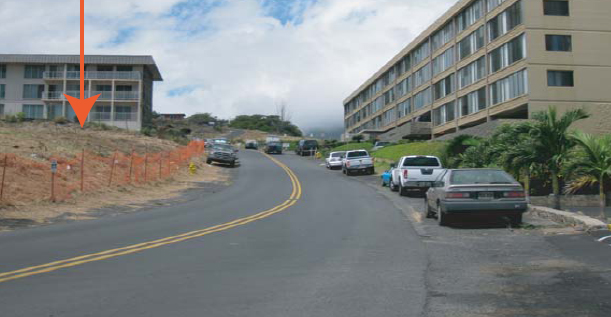
Ime Ike affordable housing project site from Pio Place. Photo courtesy Chris Hart & Partners Inc.
Creating an Affordable Housing Fund:
Maui County families face their own challenges as they can’t even afford to rent a home here, much less come up with a down-payment to buy a new one. Craigslist lists a one bedroom, one bath rental for more than a thousand dollars – often times much more. Meanwhile, the median price for a single family home is listed at around $655,000 and condominiums for $537,000 according to the Realtors Association of Maui.
If you are on Section 8 housing assistance, the wait for a home is even longer. You either can’t find a home for rent, or you can’t find a landlord willing to accept HUD vouchers.
This is why I feel that we must act now to create an Affordable Housing Fund. This fund would draw upon 3% of our Maui County property tax collection to create affordable homes and rentals – including apartment buildings, duplexes, townhouses and whatever else we need to deal with this housing crisis.
This Affordable Housing Fund will start with $9 million, to be included in this year’s budget, to purchase land for housing projects. This proposed fund would be overseen and directed by Council Finance and Budget Committee Chair Riki Hokama. Under his direction, the administration’s Affordable Housing Property Acquisition Committee hopes to create more affordable housing projects such as the one we have completed at Kulamalu.
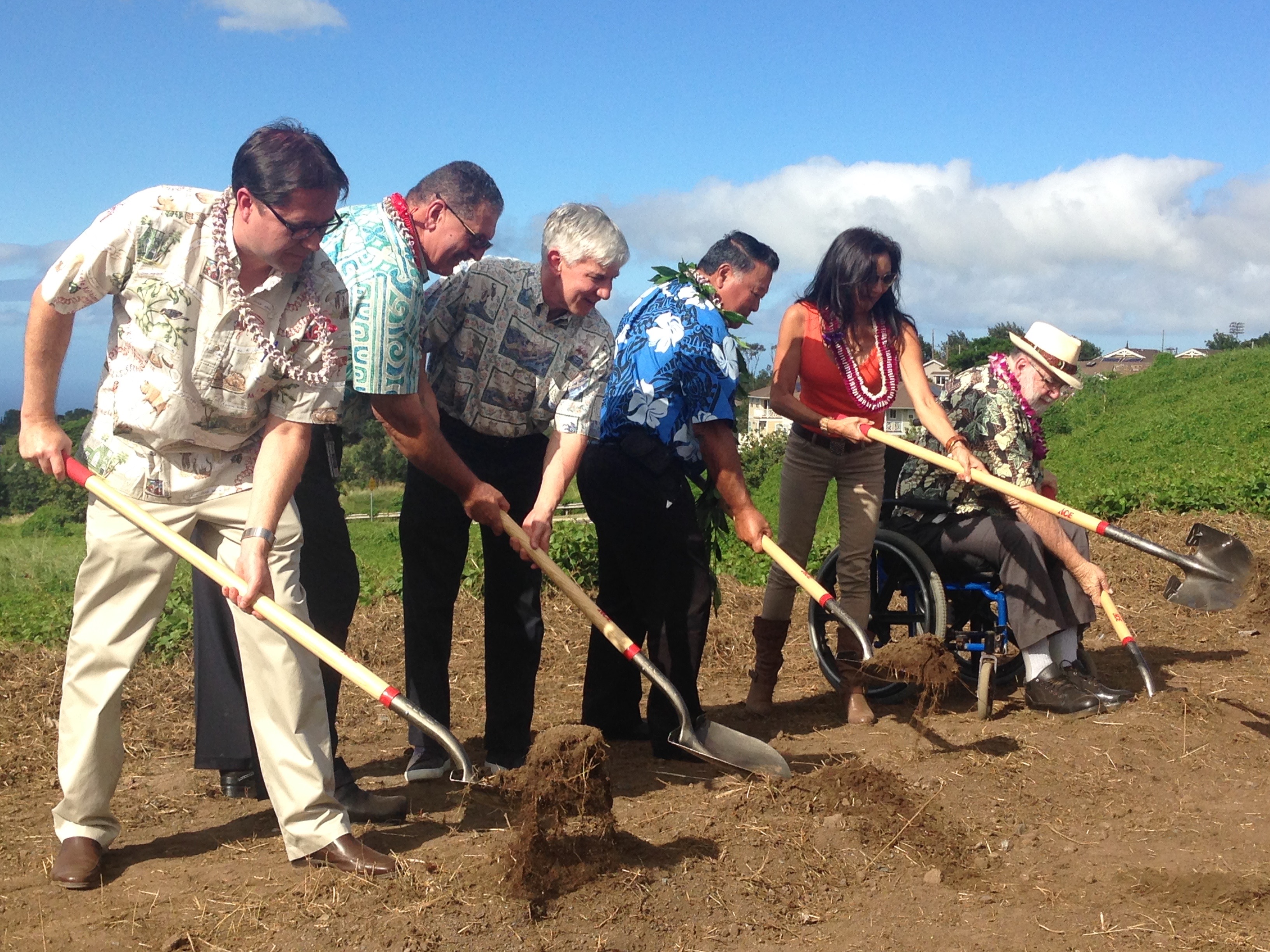
Kulamalu affordable rental groundbreaking, Dec. 10, 2015. Debra Lordan photo.
By the end of this summer we will have ready for occupancy 56 affordable rentals available at what is now known as the Kulamalu Hale affordable rental project, the first such affordable rental community being made available upcountry in many years. Mahalo to the Department of Housing & Human Concerns Director Carol Reimann and Managing Director Keith Regan for their fine work putting this project together and getting it completed.
On Lānaʻi we are working with Pulama Lānaʻi, and moving forward with a plan to provide affordable housing. A recent door-to-door survey of more than 400 Lānaʻi households has helped to determine the number of residents wanting housing units on Lānaʻi and what kind of units are desired.
The survey results indicate that the county should begin by building multi-family affordable rentals along with homeowner education to allow residents to save for a down payment, with plans to phase-in single-family homes later on.
This fund, the creation of affordable housing and homeless housing, is Maui County’s most immediate priority. I look forward to seeing it in the capable hands of Councilman Hokama and his committee.

Police sub-station on Market Street in Wailuku. Maui Now reader photo.
Addressing Homelessness: Clean and Safe Program in Wailuku
In the meantime, we have seen some success at putting our homeless population back to work and giving them a sense of purpose in Wailuku Town.
Our Clean and Safe Program has homeless workers sweeping the streets, cleaning graffiti and pulling weeds as well as other public projects. Many thanks to former Maui police officer Lawrence Kauhaʻahaʻa, Mental Health Kōkua and the Maui Redevelopment Agency for taking the time to work with local business owners and members of the homeless community, to find common ground and common sense solutions. We are hoping to duplicate the success of this program in other troubled areas.
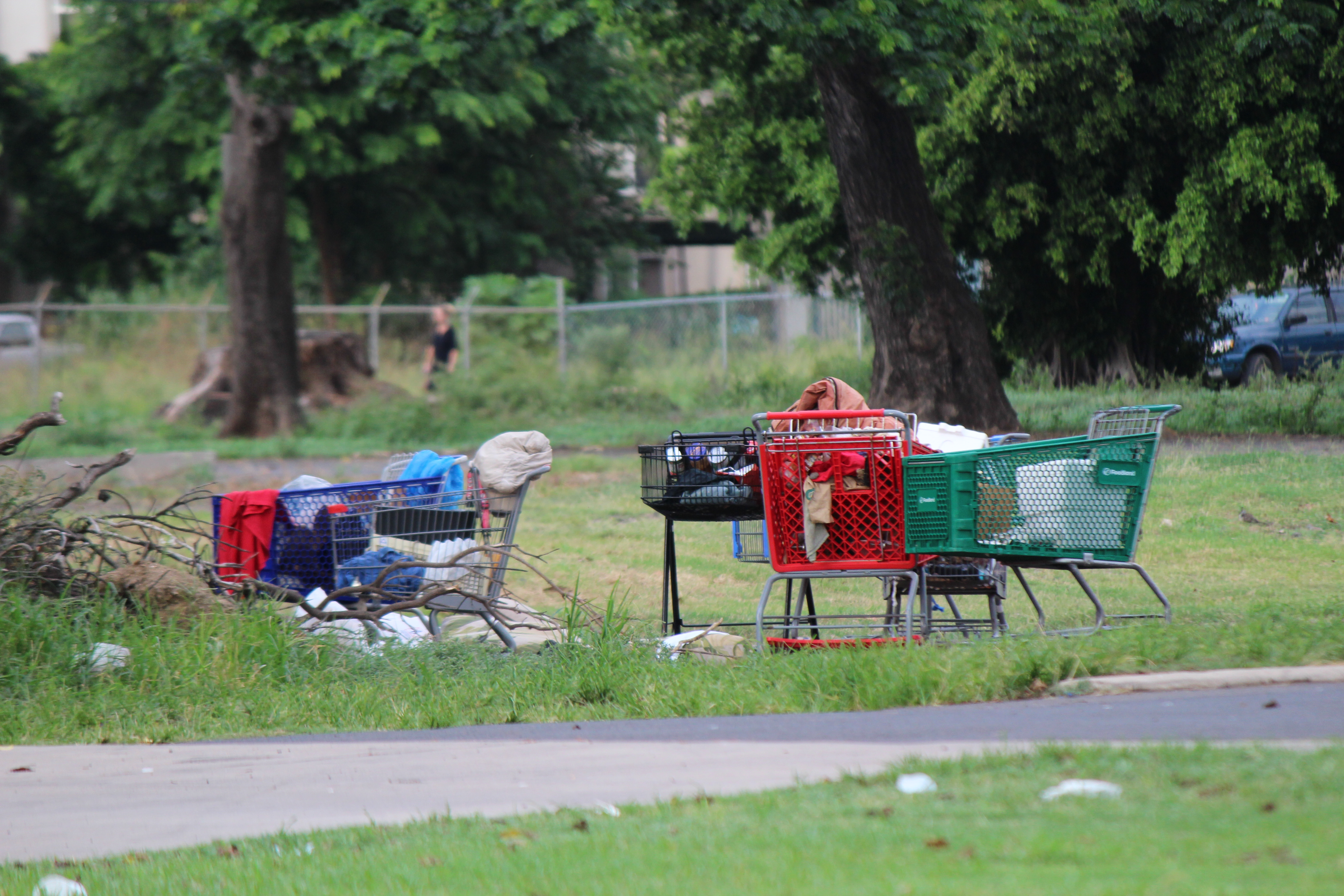
Shopping carts used by homeless individuals in the vacant lot next to the Family Life Center in Kahului. Photo by Wendy Osher.
Addressing Homelessness: Kīhei Delta Project
In Kīhei, our Housing Department has collaborated with St. Theresa’s Church and the surrounding businesses and neighbors to form the Kīhei Delta Project. This project will build upon the church’s very successful Hale Kau Kau program by making social services and mental health outreach also available.
The county has just hired our first Homeless Coordinator, David Nakama. David has years of experience in this field and will be working in collaboration with service providers, federal, state and county agencies to address homeless impacts and support housing initiatives.

As part of the ceremony to bless a new Maui biofuel crop project, each attendee planted a sunflower seed on the 115 acre site located in central Maui. Courtesy photo.
Post Sugar: Expanding Agricultural Parks Island-Wide
In relation to our economy, the loss of HC&S sugar operations still reverberates throughout our community. While many former sugar plantation workers have found other employment, there is a lot of concern about what will now happen to the thousands of acres of agricultural land that is no longer growing sugar cane.
This is why the county is proposing to expand agricultural parks island-wide. Our Kula Ag Park currently produces 360 acres of fresh farmed fruits, vegetables, flowers and nursery plants. We are working to expand the park by purchasing another 869 acres of former HC&S land. This proposed purchase includes a 54 million gallon reservoir so farmers will have access to water.
In Haʻikū, we are working with the Hawaiʻi Farmer’s Union Foundation to create Maui County’s first organic ag park and food hub on a 20 acre parcel in Paʻuwela that is owned by the county. This is on the same property where we are proposing to build a Haʻikū Fire Station.
And on the 267 acres that make up the Hamakualoa Open Space Park Preserve, County Council members Don Guzman and Elle Cochran are looking at creating another organic ag park. We look forward to seeing their ideas as part of the master plan for that area.
FYI, we are asking Representative Kyle Yamashita for state money to help fund these projects, as they all demonstrate the county’s dedication to grow more sustainable agriculture on our island.

The Festival provided the Maui Coffee Association with a strong vehicle to get the word out that Maui grows great coffee. Photo by Casey Nishikawa
Growing the Economy:
We are also growing our economic future by supporting our small business manufacturers out there. Our Made in Maui County Festival continues to break records each year, with last year’s festival generating half a million dollars in sales over just a day and a half.
Our television and film industry also had a banner year last year, generating $15 million in commercials, music videos, photo shoots and other productions. Mahalo to Film Commissioner Tracy Bennett for all his hard work and we hope to hear more good news about the industry this year as well.

Lieutenant Governor Shan Tsutsui and Mayor Alan Arakawa joined in installing a healthy living sign on Market Street, and in the spirit of healthy living touted by event organizers, proceeded to walk to their next meeting together.
Redeveloping Wailuku: $4.5M for Municipal Parking
In Wailuku we are planning to invest $4.5 million this year, and much more over the next two years, into developing a municipal parking facility and community events space. This facility will help alleviate parking issues in Wailuku Town while at the same time providing a real events center for Wailuku First Friday, food truck nights, car shows and other great events.
This project continues our efforts to redevelop Wailuku into a vibrant business community once again, mahalo to county planners Erin Wade, David Yamashita and all the Wailuku business owners for your cooperation, hard work and creativity.
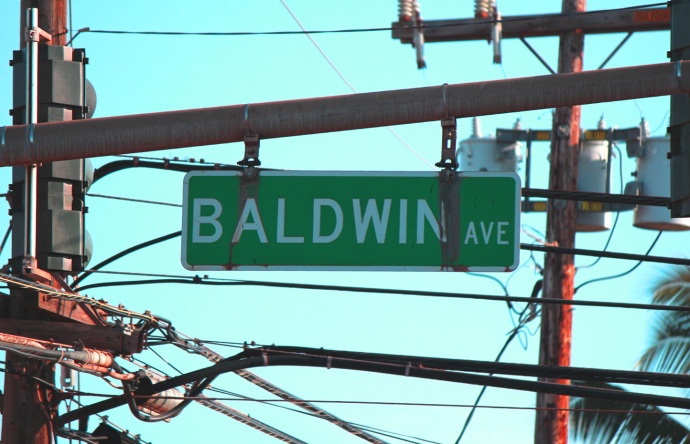
Baldwin Avenue. Photo by Wendy Osher.
Improving Infrastructure: Baldwin Avenue Reconstruction, Pāʻia Sidewalk Repair
Our dedication to maintaining and improving our county infrastructure remains as strong as ever. One of our bigger road projects, the $3.9 million reconstruction of Baldwin Avenue from Hāna Highway to Hāliʻimaile Road has already begun.
This includes repair of the sidewalk between Pāʻia Elementary School and Pāʻia Gymnasium, so that students can safely evacuate the campus during times of emergency, as part of our Safe Routes to School initiative.
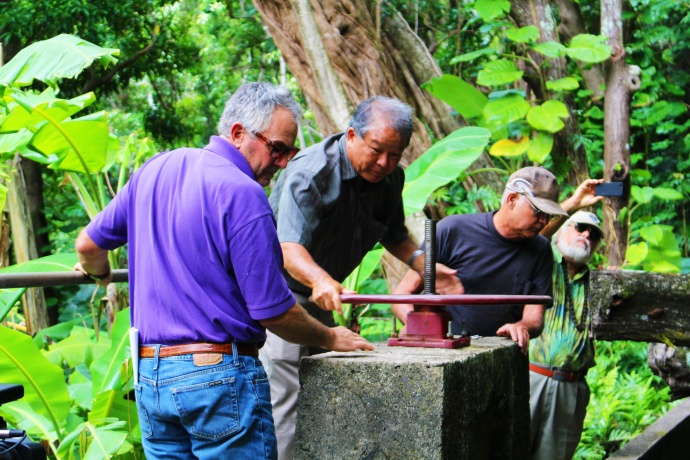
Wailuku Water Company president Avery Chumbley (left with purple shirt) oversees the release of 10 mgd of water above Kepaniwai. The release was part of an agreement reached with several environmental groups including Hui O Nā Wai ʻEhā and Earthjustice. Photo by Wendy Osher.
$20M ʻĪao Water Surface Treatment Facility:
We have also begun the construction of our ʻĪao Water Surface Treatment facility this year. This $20 million project will process the extra 1.5 million gallons a day that the county is to receive due to the successful agreement of the Nā Wai ʻEha decision.
We have before council a proposal to purchase even more water infrastructure from the Wailuku Water Company. The proposal consists of buying 8,764 acres of land in the West Maui watershed along with its water conveyance system for $9.5 million.
This proposal will assure us that the kuleana users will be able to secure water for farming taro and other crops. This will also ensure the protection of our watershed area so that a private company will not be able to hold our water hostage, or try to use it as a bargaining chip.
This will also protect the historic and culturally significant areas in ʻĪao Valley.
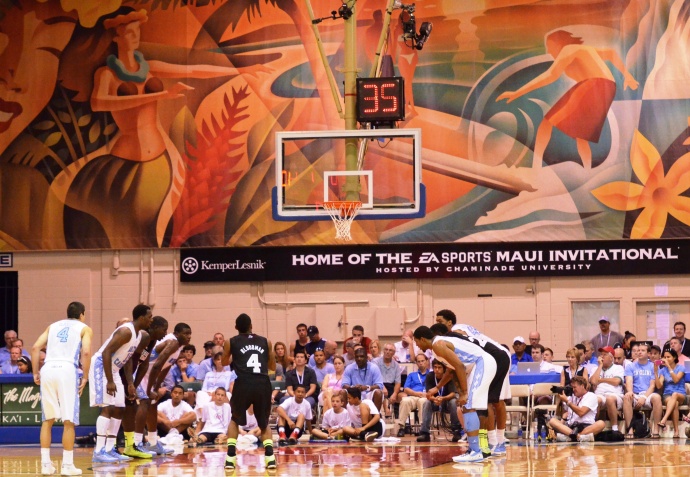
The Lahaina Civic Center is host to the annual Maui Invitational Basketball Tournament. File photo by Rodney S. Yap.
Lahaina Civic Center Expansion
Over in West Maui the County Council has approved a dollar a year lease from the State of Hawaiʻi to expand the Lahaina Civic Center area by 20 acres.
This will allow us to provide more event parking, as well as make some much needed improvements to our Lahaina fire and police stations, which are located on the same property. Mahalo to Councilmember Yuki Lei Sugimura and her committee for their support.
Search for Property on Molokaʻi for Emergency Shelter/Gym
We continue to aggressively search for property on Molokaʻi to build a brand new gymnasium/emergency shelter for the community. This new gym would be built to FEMA standards so that we could also use it during tsunami and hurricane events.
This idea for a Molokaʻi gym and shelter came from the late Mele Carroll, our former state representative, before she passed, and it is currently being championed by Councilmember Stacy Crivello. I know that Mele would be very pleased.

Maui Business Park. File photo by Wendy Osher.
DMVL Makes $28M Move to A&B Business Park
In Kahului we are still preparing to move our main service center of the Division of Motor Vehicles and Licensing from the Maui Mall to our property at the new A&B Business Park. This is a $28 million project which will house many other county offices, including motor vehicles and licensing, real property tax, housing, inspectors and the Office of Economic Development.
This move will eventually allow us to stop paying millions of dollars in rent.
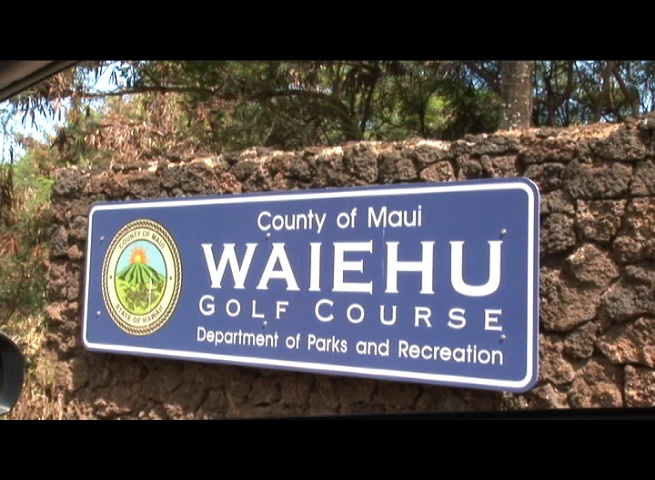
Waiehu Golf course sign. Photo by Wendy Osher.
Waiehu Municipal Golf Course to Close
On another cost saving note, we are looking at closing down operations at our Waiehu Municipal Golf Course. It is a very popular course for our residents, especially senior and keiki golfers, however it is operating at close to a $3 million loss annually, specifically at a $16.3 million loss over the last 10 years.
The proposed closure will not result in any layoffs as the 20 park personnel at the course will be transferred to work at other park facilities around the island. While this comes as a blow for many local golfers who use the Waiehu course often, the county is proposing to subsidize golf fees for seniors and junior golfers to play at other courses.

ʻĪao Valley, erosion and flood debris from flash flood. PC: 9.14.16 by Wendy Osher.
Historic ʻĪao Flood: Repairs Underway
Before we wrap up tonight, I would like to thank the men and women who worked tirelessly to fix Kepaniwai Park, our Flood Control along ʻĪao and Kahoma, as well as other areas last year.
This was a monumental, once in a lifetime event, somewhere between a one hundred year and a five hundred year flood. That night, residents said they heard thunder, but really it was boulders rolling down the Wailuku River at incredible speeds.
Our county crews worked fast and hard to get repairs underway, at times placing their own lives in danger. Timing was critical, because right after that flood we had another flood event on New Year’s Eve, which caused no damage due to the repairs made to our flood control. Without those repairs, flood waters could have damaged homes from ʻĪao Parkside to Paukūkalo, and businesses all along Lower Main Street.
Mahalo for all your hard work and know that the community appreciates your efforts, and so do I. You all make me very proud to be part of our county family.
Closing:
In closing, it seems that many of the challenges Maui County faces, are due to our own success. We are a vibrant, active and healthy community, so much so that we are now seeing five generations of families alive and well at the same time.
Of course, this also means we require more senior services, medical care and hospital facilities. After years of fighting for better medical services, we look forward to Kaiser taking over as our acute care provider.
We would also like to thank Bryan Hoyle for starting construction on the West Maui Medical Center, a much needed hospital for Lahaina.
This vibrancy has also attracted the very rich and affluent, and our real estate prices reflect that. The price of paradise here is no longer affordable for many, and unfortunately our population grew beyond our affordable housing inventory.
Our unemployment numbers have decreased to record lows but our economy remains vulnerable with losses in agriculture and our heavy dependence upon tourism and construction.
We must continue to seek ways to diversify our economy and create career paths for our next generation.
Finally, homelessness is visible everywhere, and we must find a way to offer comfort and help to those on the streets while at the same time provide security and protection to the rest of the community. These are our challenges here, and at the same time our opportunities. Our future will depend on which path we take from here.
We must continue to set the course into the next century and do what is right and what is necessary, so the next generation has the quality of life that we aspire them to achieve. Along the way we may disagree with each other, but that’s okay too. One side doesn’t have to lose in order for the other side to win. You can stick up for what you believe in, and still work together to help propel this community forward.
I think as long as we remember that, we will be able to focus on what is really important. That we are here for the people of this community, to protect them and serve them, and to improve the quality of life for all.
And so, I bid you aloha, God bless, and thank you for all you do to make Maui County the best community in the world. Thank you for joining us tonight. Mahalo and aloha.









